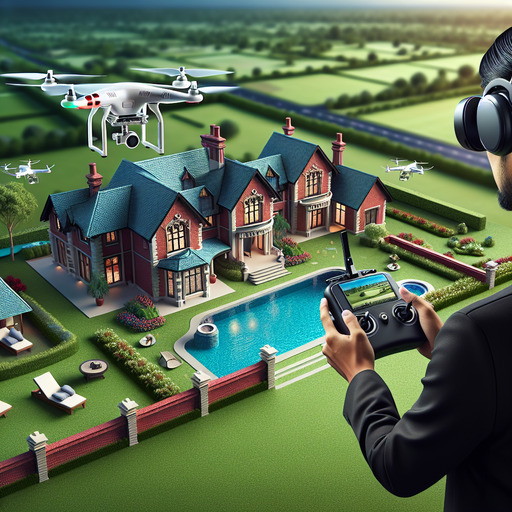
-
Table of Contents
Unlock the full potential of your real estate listings with cutting-edge video drone techniques for professional shoots. Elevate your property presentations and captivate potential buyers with stunning aerial footage. Learn more.
Introduction
Real estate video drone techniques have revolutionized the way properties are showcased, offering dynamic and captivating perspectives that traditional photography simply cannot match. Utilizing drones for professional shoots allows real estate agents and marketers to capture stunning aerial views, sweeping panoramas, and intricate details of properties, enhancing the visual appeal and providing potential buyers with a comprehensive understanding of the property’s layout and surroundings. Key techniques include planning flight paths to highlight key features, using smooth and steady camera movements to create cinematic footage, and employing advanced editing software to enhance the final product. By mastering these techniques, real estate professionals can create compelling video content that stands out in a competitive market, ultimately driving higher engagement and interest from prospective buyers.
Mastering Real Estate Video Drone Techniques for Professional Shoots: Elevate Your Property Video Tours and Listings
Mastering real estate video drone techniques for professional shoots can significantly elevate your property video tours and listings, offering potential buyers a unique and comprehensive view of the property. As the real estate market becomes increasingly competitive, leveraging advanced technology like drones can set your listings apart. To achieve this, it is essential to understand and implement various drone techniques that can enhance the visual appeal and informational value of your videos.
First and foremost, planning is crucial. Before taking to the skies, it is important to conduct a thorough pre-flight survey of the property. This involves identifying key features that should be highlighted, such as the property’s layout, surrounding landscape, and any unique architectural elements. By mapping out your flight path and shot list in advance, you can ensure that you capture all the necessary footage efficiently and effectively.
Transitioning from planning to execution, the choice of drone and camera equipment plays a pivotal role. High-quality drones equipped with 4K cameras and gimbal stabilization systems are recommended for professional real estate shoots. These features ensure that the footage is crisp, clear, and stable, providing a polished final product. Additionally, drones with obstacle avoidance technology can help prevent accidents and ensure smooth flight operations.
Once the equipment is set up, mastering the art of smooth and controlled flight is essential. Slow, steady movements are key to creating professional-looking videos. Quick, jerky motions can be disorienting and detract from the viewing experience. Practicing basic maneuvers such as panning, tilting, and orbiting can help you achieve fluid and dynamic shots. For instance, a slow pan across the front of the property can provide a grand, sweeping view, while an orbit around a focal point, like a swimming pool or garden, can highlight specific features in an engaging manner.
In addition to smooth flight techniques, varying your shot types can add depth and interest to your video. Wide-angle shots can capture the entire property and its surroundings, giving viewers a sense of scale and context. Conversely, close-up shots can focus on intricate details, such as custom woodwork or landscaping, that might be missed in broader views. Combining these different perspectives can create a more comprehensive and captivating video tour.
Lighting is another critical factor to consider. The time of day and weather conditions can greatly impact the quality of your footage. Shooting during the golden hours—shortly after sunrise or before sunset—can provide soft, warm lighting that enhances the property’s appearance. Overcast days can also be beneficial, as the diffused light reduces harsh shadows and creates a more even exposure. Monitoring weather forecasts and being flexible with your shooting schedule can help you capture the best possible footage.
Post-production is where your raw footage is transformed into a polished final product. Editing software allows you to trim and arrange clips, adjust colors and exposure, and add music or voiceovers to enhance the viewing experience. Incorporating smooth transitions between shots can create a cohesive and professional video. Additionally, adding text overlays or graphics can provide viewers with important information, such as property dimensions or key features.
In conclusion, mastering real estate video drone techniques requires careful planning, the right equipment, skilled flight maneuvers, attention to lighting, and meticulous post-production. By investing time and effort into these areas, you can create stunning property video tours that captivate potential buyers and elevate your real estate listings.
Q&A
1. **Question:** What are some key techniques for capturing high-quality real estate videos using drones?
**Answer:** Key techniques for capturing high-quality real estate videos using drones include:
– **Pre-Flight Planning:** Scout the property and plan your shots to ensure you capture all key features.
– **Smooth Movements:** Use slow, steady movements to create professional-looking footage.
– **Optimal Lighting:** Shoot during golden hours (early morning or late afternoon) for the best natural lighting.
– **Proper Altitude:** Maintain a consistent altitude to provide a clear perspective of the property.
– **Gimbal Use:** Utilize a gimbal to stabilize the camera and reduce shakiness.
– **Variety of Angles:** Capture a mix of wide shots, close-ups, and different angles to showcase the property’s features.
– **Editing:** Use professional editing software to enhance the footage, add music, and create a cohesive video.